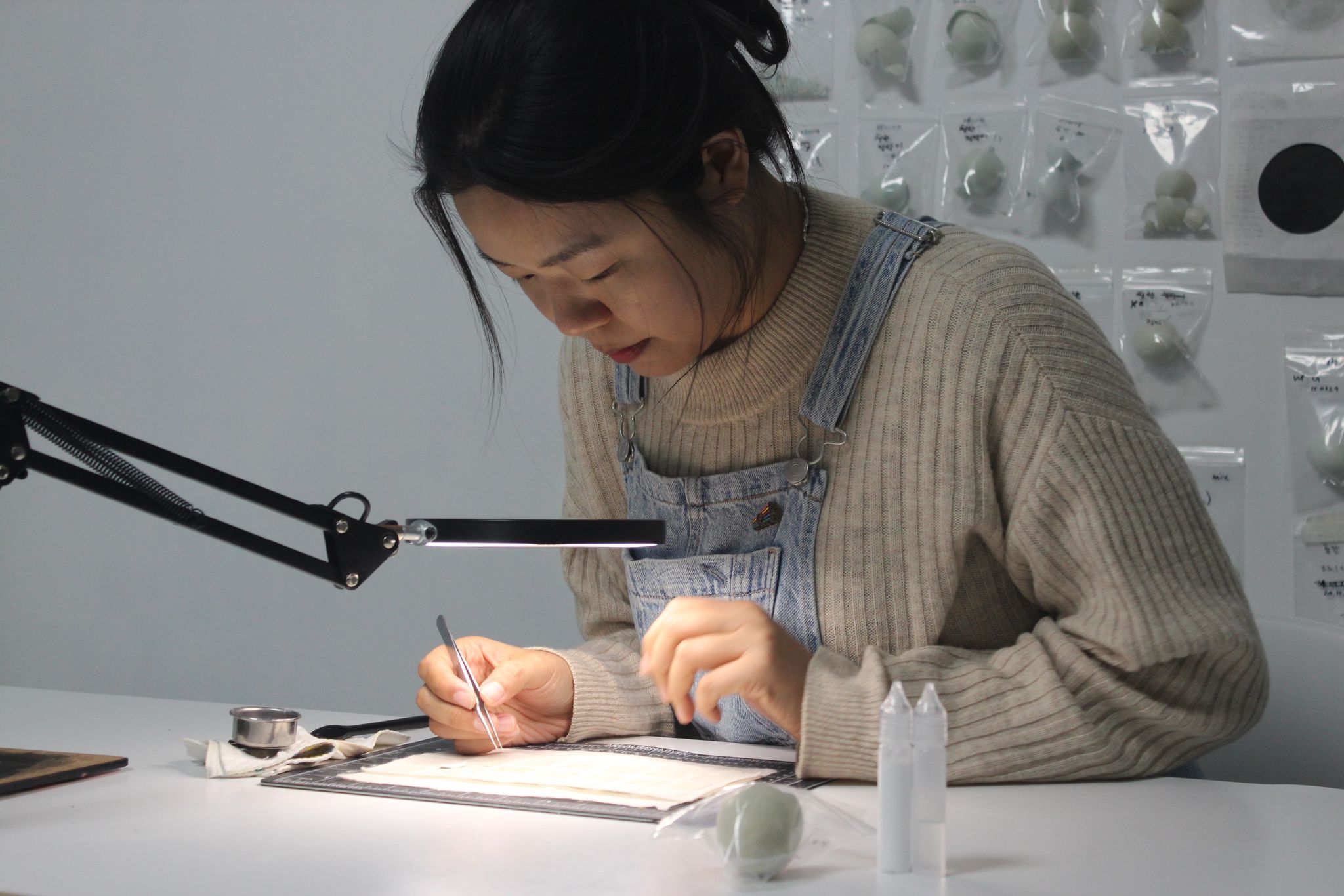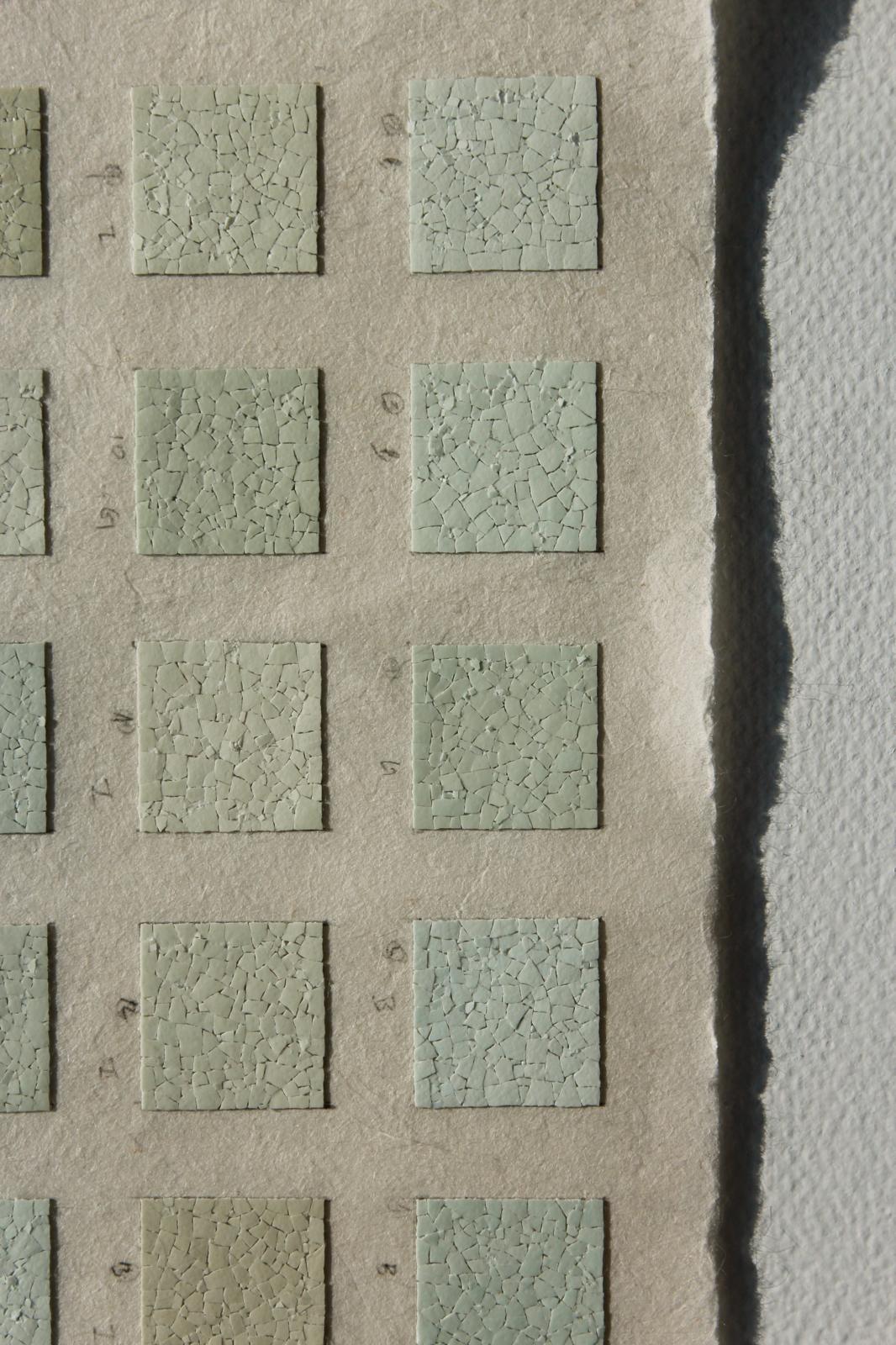
Community
Minkyung
KEY WORDS
instant connection, cultural comfort, self-discovery, art practice, conceptual change, creative studio, mundane to magical, attention to detail, eggshell art, community building, traditional crafts, interconnectedness
Minkyung is a Korean-Canadian artist based in New York whose work illuminates the often-overlooked intricacies of daily life and celebrates the subtle colors and textures of nature. Her practice centers on capturing delicate phenomena, like the nuanced shifts in color and the gentle play of shadows on surfaces, drawing viewers’ attention to the beauty in life’s smallest details. Using natural and raw materials, Minkyung’s work evokes a sense of intimacy and wonder, inviting audiences to immerse themselves in the details of her creations.
Her work embodies the Korean concept of "아기자기" (agi-jagi), which translates to harmonious, picturesque, and precious—a quality she achieves through carefully selected materials and meticulous craftsmanship. Everyday materials such as soil, paper, and eggshells are transformed, taking on new significance through a process akin to ascetic devotion. With delicate forms, organic textures, and curated colors, Minkyung transports viewers into a world where each piece serves as a portal to explore the subtle nuances of existence.
This conversation took place in October 2024 in Lisbon, Portugal.
KT
Okay, so I usually start these conversations with how I've met the person. For us it's obviously very unique.
M
Yeah. Do you usually start with your version, or do we both talk about it?
KT
Oh, interesting question. I guess both - it just gives us a point of origin and context for readers about where the conversation could go. For us, we literally just met one month ago in an artist residency in Lisbon, or under a month ago. We became flatmates. I feel like there was an instant connection. You had already been in Lisbon for a month and knew your way around, and I felt very comforted by that. You also knew Canada, you've lived there, and then most recently, you were living in New York. There was a lot of immediate comfort, culturally, and I was introduced to Lisbon through you essentially.
M
That's weird because I feel like I still don't know anything about Lisbon! *laughs* But yeah, it's always nerve-wracking to meet a new person, especially when you don't have any idea how they are or what their personality is. But I think with you, it was very easygoing, maybe because of, I don't know, some kind of energy. You’re very soft spoken, gentle, and especially being a Canadian, I was like, ‘Oh, she's gonna be nice.’ *laughs* Sometimes you get a jolt of energy with interactions, or it's very mysterious. Then after time, you get used to it, and you kind of see the clarity in ‘Oh, like, that’s what this is gonna be like.’ But I think with you, it has been consistent from the start. My feelings and my impression of you, and it hasn't changed.
KT
I feel the same about you. I also think maybe it goes to show where we're both at in our lives and like, discovering ourselves maybe? Though there might be a lot of uncertainty in our next steps, we both shared that we're in the middle of moves, mine less drastic, but just moving, putting all my stuff in storage before coming to Lisbon, and then moving into a different apartment when I get back, and you having to send a whole bunch of your stuff back to Korea, and then moving fully to Korea when you get back, even though those uncertainties exist, I think we have a sense of self that we've shared we've worked quite hard to discover.
“I still remember when my mom said, ‘we thought you knew how to write Korean because you wrote a word, like letters on paper with a pencil.’ In the end, she realized I was just copying shapes of words. I think from then I was very intrigued in copying, or kind of translating an image into another form, or just mimicking it.”
– Minkyung
M
Yeah, and being certain about what we're doing, right? And taking this leap of faith to do the artist residency. We're still raw in terms of exploring and having faith, and that comes with a certain confidence. And for you and I, we’re kind of similar in how we make decisions, like, I have to have X amount of certainty to apply and go forth, versus some other people may be more immediate, like, ‘I'm just gonna do it’.
KT
Yeah, yeah, totally. I'd love for you to explain a bit about your art practice, and if you've always considered yourself an artist.
M
I guess my art practice all started with what I liked. I still remember when my mom said, ‘we thought you knew how to write Korean because you wrote a word, like letters on paper with a pencil.’ In the end, she realized I was just copying shapes of words. I think from then I was very intrigued in copying, or kind of translating an image into another form, or just mimicking it. And with that, she saw the potential, or she just saw that, ‘okay, that's her interest, she might be into this kind of a route in her life, doing something related to visual art, or drawing or something creative,’ And because of that, I went to, like art, not academies, but, side schools, I guess, after-school programs. That's when I was doing more of the technical practices and just enjoying the process.
I think there was a big conceptual change when I went to college for it. Up until then, I loved art and I enjoyed it, but I don't think it was personal enough. It was more about execution and just making something new that excited me, but not really delving into the conceptual part of it and for that to represent who I am and what I believe in. So during college that's when I had I don't know, I guess a different type of energy, like desire and excitement that I never felt before. That was pretty life-changing, and I wanted to feel that high with my art or the things I create. And then I think after graduating, I just tried to find it in any way I could. So even if I was working at a creative studio, I would try to always go back into my own practice or try to make something that I enjoyed, to kind of figure out the essence of what I'm trying to make.
And as you know, in the past few years, I was frustrated with work and my own art practice, and I got to a point where I'm just going to take a leap of faith to really dedicate appropriate time to my own practice, and that's why I am here in Lisbon. I am very thankful to my past self for taking that action because through continuing a practice that I was a little unsure about, the residency allowed me to enjoy the whole process of finding materials and execution and enjoy building a community within the artwork. At this point, I feel like it is me executing, but it's my artwork that's driving itself to a new form, which is really exciting.
![]()
![]()
I think there was a big conceptual change when I went to college for it. Up until then, I loved art and I enjoyed it, but I don't think it was personal enough. It was more about execution and just making something new that excited me, but not really delving into the conceptual part of it and for that to represent who I am and what I believe in. So during college that's when I had I don't know, I guess a different type of energy, like desire and excitement that I never felt before. That was pretty life-changing, and I wanted to feel that high with my art or the things I create. And then I think after graduating, I just tried to find it in any way I could. So even if I was working at a creative studio, I would try to always go back into my own practice or try to make something that I enjoyed, to kind of figure out the essence of what I'm trying to make.
And as you know, in the past few years, I was frustrated with work and my own art practice, and I got to a point where I'm just going to take a leap of faith to really dedicate appropriate time to my own practice, and that's why I am here in Lisbon. I am very thankful to my past self for taking that action because through continuing a practice that I was a little unsure about, the residency allowed me to enjoy the whole process of finding materials and execution and enjoy building a community within the artwork. At this point, I feel like it is me executing, but it's my artwork that's driving itself to a new form, which is really exciting.
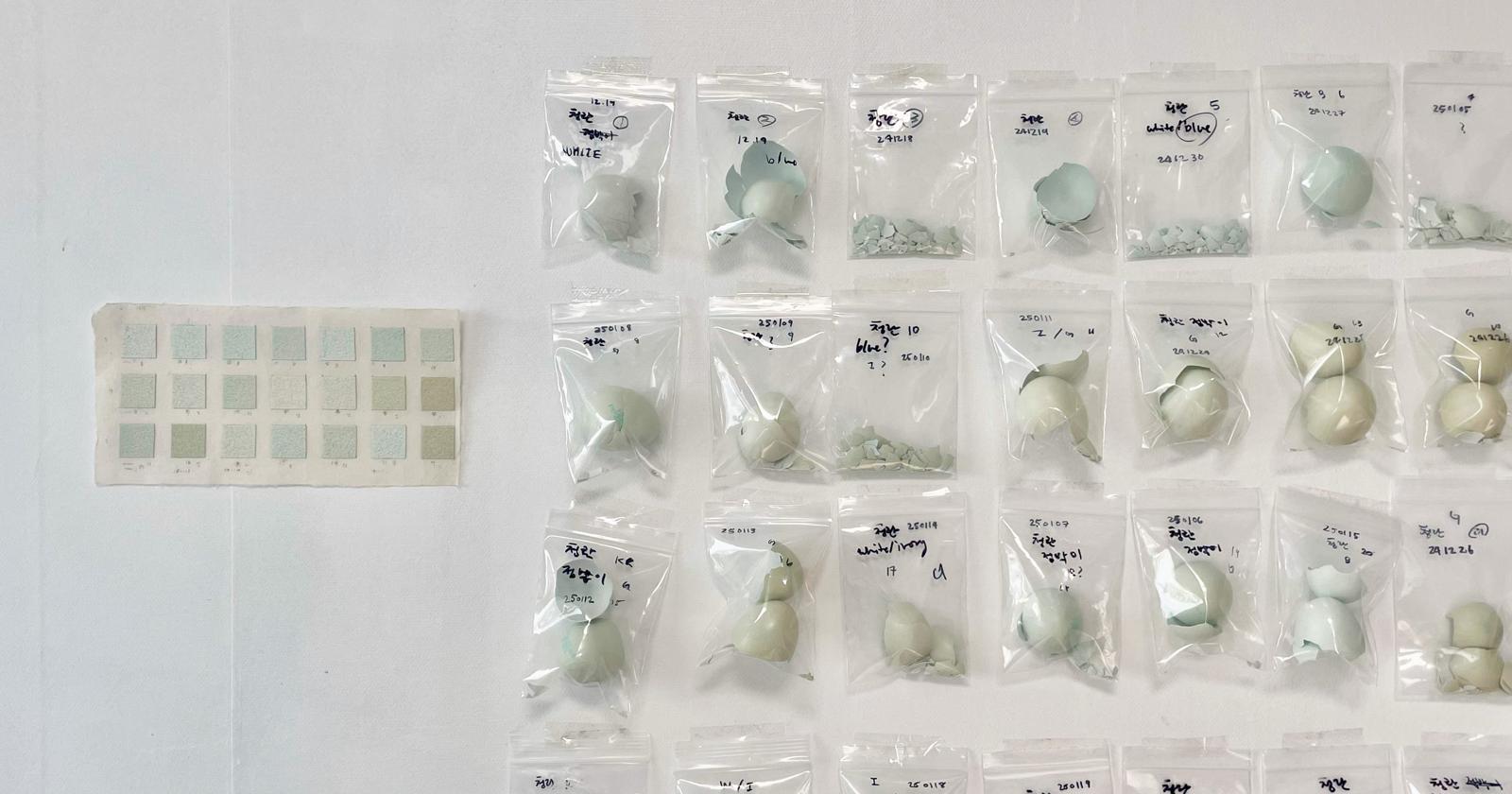



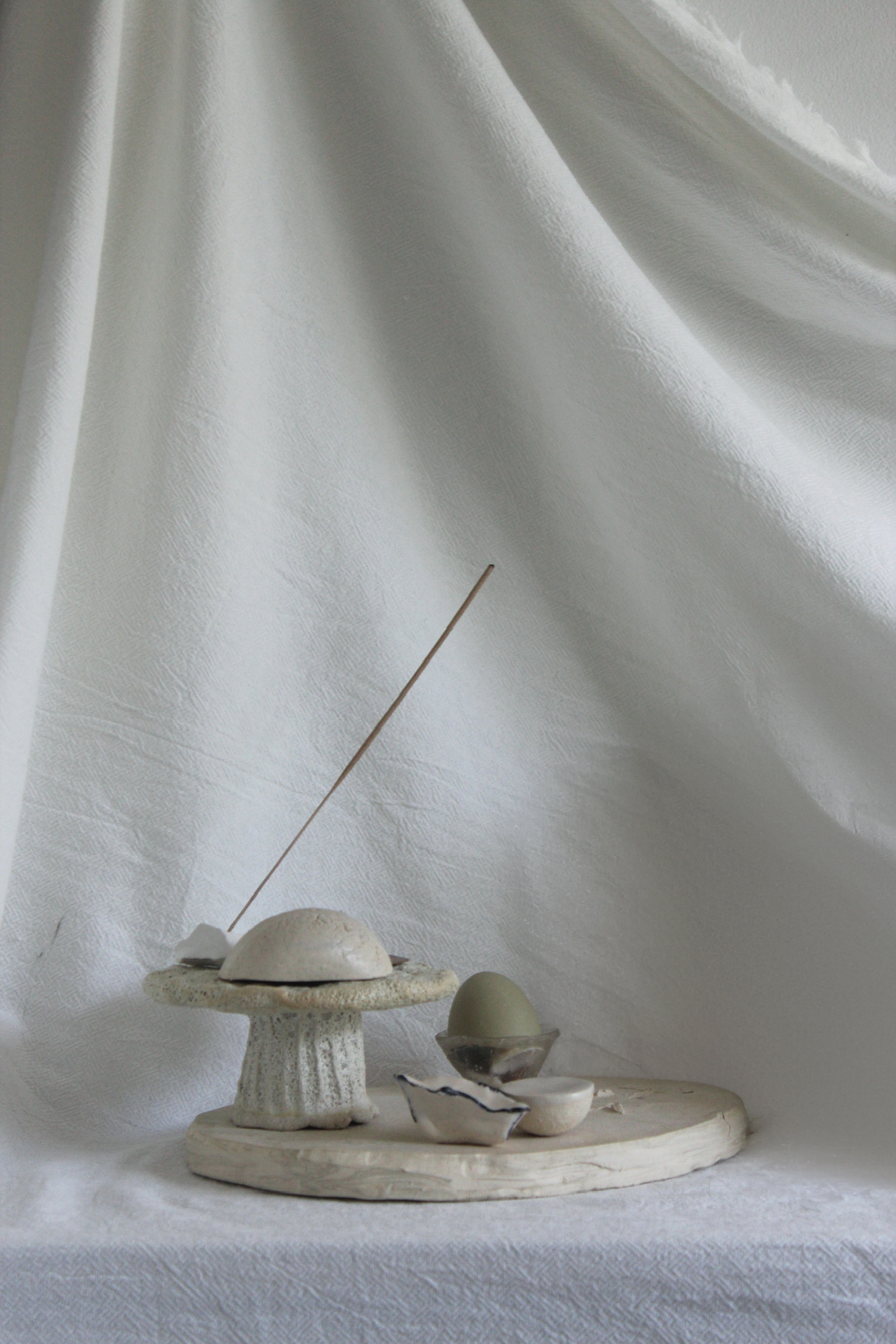
KT
That's really cool. I love that. So you've already shared a bit of this in the answer you just gave. But what or who do you bring forward with you in your work? Could be anything. I think you touched a bit on how your work became more personal and explored more conceptual foundations and beliefs, what do you mean when you say that? Or, like, what about yourself comes forward, or your family, or your, yeah, inspirations?
M
A few keywords that would represent my work would be poetic-ness and mundane to magical and finding happiness in small things. I have great attention to detail, and I usually focus on one thing and I'm like, ‘I like that, and I really want to dig into it.’ It makes me think of this Korean phrase that is derived from Buddhism. It's called "소확행" (so-hwak-haeng), and it means you're feeling happiness, or you're getting happiness with small things, and through the practice of being happy with small events happening in your life, you're able to achieve a well-rounded life. This might not be the exact answer or like, meaning of 소확행 (so-hwak-haeng) but during times when people were very stressed, and during the pandemic, this term was, very, very popular, because everyone was frustrated; they had to find some happiness in their life during this very uncertain, isolated, and constrained environment. So even waking up in the morning, watching a sunset—like what we're doing right now—or even just bumping into someone new. That could be an element of happiness that we can achieve.
“Like how I assemble these tiny shards of eggshells together, it takes such a long time and a high level of focus, and in a way, it’s a tedious technique to complete it. I think the material is able to be transformed into something so precious. I like the contrast of something about to be forgotten becoming something dear.”– Minkyung
KT
I think this is a good place for you to elaborate on the materials that you were using in this residency, and how you really put into practice the mundane to the magical and attention to detail, the beauty in those like small details.
M
I guess it all started... this is a story that I've told so many times here in Lisbon.
KT
You can just direct them to this interview next time people ask.
*laughs*
*laughs*
M
Yeah, here, listen to this record!
So it all started during the pandemic, going to the farmers market on Saturdays and seeing these beautiful coloured eggs from farmers from upstate New York. I thought the colours were so beautiful because they came in greens and blues and very, very dark browns, and even some khaki colours. So, I started to collect them. I would eat the inside, obviously, and then wash the shells, peel the inner filaments, dry them out in the sun and then collect them in a box. It made me really happy. I was like, ‘Oh, I have collections of different colours, khaki colours, blues, different shades of blue that I didn't think I would see.’ I was doing that for a year and I got to a point where I was like, ‘Okay, I can't just keep them as a shell, what do I do?’
That made me go back to the reason why I started collecting them- the unique colour, the colour that already exists in nature that we often overlook because we are so, I guess, driven by the main goal, right? For example, with an egg, the goal is to eat the content inside the shell. Therefore, the shell is just a carrier to hold the content. And after you break it, it becomes garbage or a fertilizer, which is useful. I like the idea of turning something mundane into something magical, or taking something that we dismiss and through dedication of time, turning it into something precious. Like how I assemble these tiny shards of eggshells together, it takes such a long time and a high level of focus, and in a way, it’s a tedious technique to complete it. I think the material is able to be transformed into something so precious. I like the contrast of something about to be forgotten becoming something dear. Or something that we just pass by every day, suddenly having importance because of the way it has changed form.
I also just wanted a moment for people to just look at the colour of nature, you know? Not just acrylic paints or man-made colours, which could be very beautiful too, but I think we often forget to appreciate the things that we already have. And for me, that's a little sad, because it means we can never be happy. But in a way, happiness is always here. It's just that we forget to look at it, and we've been trying to find it somewhere else. So, through my work, I want people to look back into what they have missed, and have a moment to just look at one thing in a very hyper-focused way and just forget about what's around them and just appreciate the thing in front of them.
So it all started during the pandemic, going to the farmers market on Saturdays and seeing these beautiful coloured eggs from farmers from upstate New York. I thought the colours were so beautiful because they came in greens and blues and very, very dark browns, and even some khaki colours. So, I started to collect them. I would eat the inside, obviously, and then wash the shells, peel the inner filaments, dry them out in the sun and then collect them in a box. It made me really happy. I was like, ‘Oh, I have collections of different colours, khaki colours, blues, different shades of blue that I didn't think I would see.’ I was doing that for a year and I got to a point where I was like, ‘Okay, I can't just keep them as a shell, what do I do?’
That made me go back to the reason why I started collecting them- the unique colour, the colour that already exists in nature that we often overlook because we are so, I guess, driven by the main goal, right? For example, with an egg, the goal is to eat the content inside the shell. Therefore, the shell is just a carrier to hold the content. And after you break it, it becomes garbage or a fertilizer, which is useful. I like the idea of turning something mundane into something magical, or taking something that we dismiss and through dedication of time, turning it into something precious. Like how I assemble these tiny shards of eggshells together, it takes such a long time and a high level of focus, and in a way, it’s a tedious technique to complete it. I think the material is able to be transformed into something so precious. I like the contrast of something about to be forgotten becoming something dear. Or something that we just pass by every day, suddenly having importance because of the way it has changed form.
I also just wanted a moment for people to just look at the colour of nature, you know? Not just acrylic paints or man-made colours, which could be very beautiful too, but I think we often forget to appreciate the things that we already have. And for me, that's a little sad, because it means we can never be happy. But in a way, happiness is always here. It's just that we forget to look at it, and we've been trying to find it somewhere else. So, through my work, I want people to look back into what they have missed, and have a moment to just look at one thing in a very hyper-focused way and just forget about what's around them and just appreciate the thing in front of them.
KT
You’re reminding me of Claudia’s collective reflection from the showcase. She was just talking about being kind of overwhelmed and even uncomfortable in nature like there's something big in reminding ourselves just how much is naturally around us that you can be in wonder and awe of, or even uncomfortable in.
M
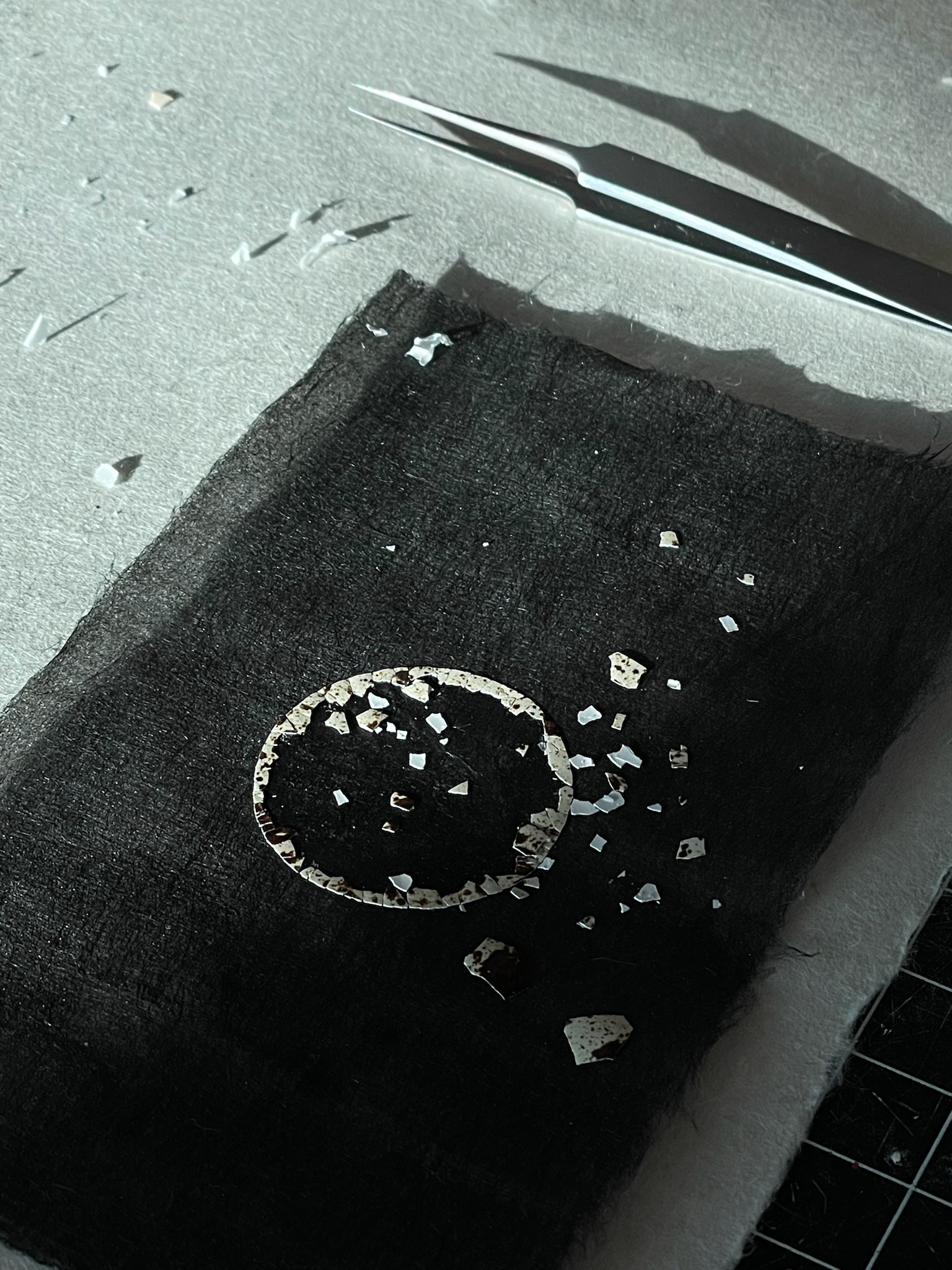
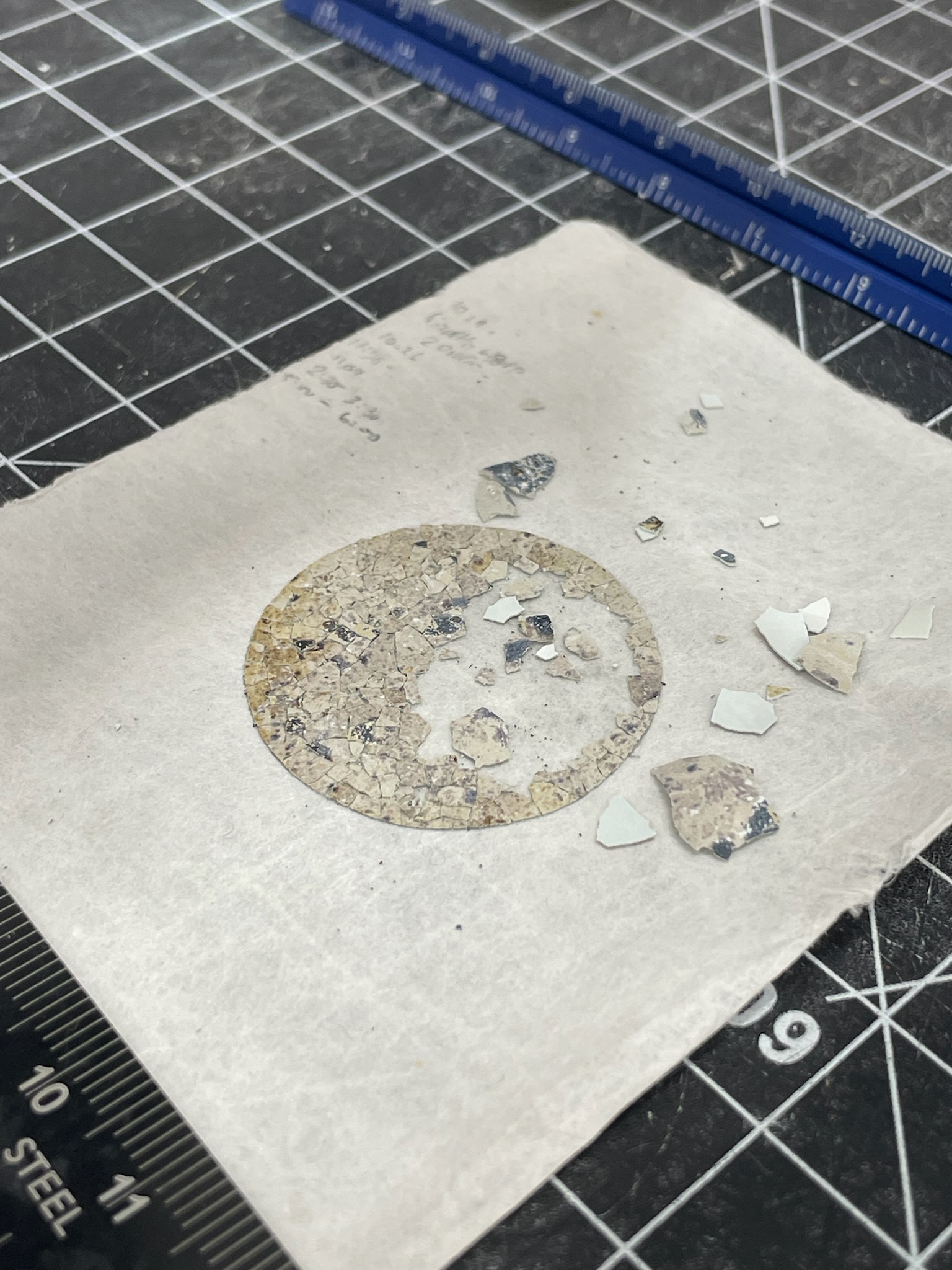

Yeah, and being present where you are. That's probably what I want. If I think about my sketches, my ceramics, the things I make, or the eggshell and seashell works that I'm doing, it’s all about presence. To observe. You have to be present and pay attention and not be distracted by what's around you but what’s in front of you. And, you know, especially these days, everyone's distracted all the time and people are forgetting to be present.
“ With the eggshells or seashells, it's sometimes good to just leave that weird spot out. As you continue on, after 20 or 30 minutes, you might find a piece that you cracked that looks like it might fit, and you put it in, and it just fits perfectly. In those moments, I'm like, ‘that was meant to be.’ That makes me think about my life and my daily situations. If things aren't working out, it's fine because there's a reason why it won't; there's another piece that's missing that will come later.”
– Minkyung
KT
Could you speak a bit more about the journey and the emotions of putting together even one singular shell piece?
M
It is a journey. Putting one piece down can hold so many feelings because there's joy, surprise, frustration, anger, confusion, and sometimes blood, sweat, and tears. I probably talked to you about this too, but as I was working on my pieces during the residency, I realized that I am becoming very humble as I'm working through the pieces. I run so many monologues as I'm putting together each shell. In a way, I find answers while I’m puzzling them together. Like if, let's say, in my life, something is not working out, maybe I would try to force it together, but in the end it's never a good result. With the eggshells or seashells, it's sometimes good to just leave that weird spot out. As you continue on, after 20 or 30 minutes, you might find a piece that you cracked that looks like it might fit, and you put it in, and it just fits perfectly. In those moments, I'm like, ‘that was meant to be.’ That makes me think about my life and my daily situations. If things aren't working out, it's fine because there's a reason why it won't; there's another piece that's missing that will come later. I don't have to stress about it right now.
KT
This next question is about ancestry, so what do you hope that archeologists of the future will find in your work? What type of ancestor do you hope to be?
M
In the physical way, I don't think my work will be alive. It will just deteriorate in the compost within the land, and that I am fine with because nothing is meant to last forever. There's a beauty within the deterioration or the fact that it's not everlasting, it allows you to be present and appreciate what's there. Also because we're living in an age where you can have digital images of everything and 3D printed things, or holograms in the future, in a way, a physicality, a tactile physicality may not exist, but the idea, the concept in digital form, it can last forever. So, in terms of what kind of ancestor I want to be, I don't I have a perfect answer of how I want to be perceived, but I hope that it will somehow allow people to rethink and think about what makes them happy, that something small can make them happy. I don't know. I think, in a joking way, I would want them to rethink an egg. If they encounter my egg, for example, all they think about is the colour of the eggshells, and notice each different tint and texture on the eggs they eat every day. In a non-jokingly way, I do want that concept to be stuck with them, to be present in their own way.
KT
Yeah, well, you've definitely impacted the residency group in that way, I would say.
M
Yeah, I'm putting them on a hunt for different eggshells. I think that is also another thing that I really appreciated through the process, sharing the work and having other people interested and invested. I even got donations of different coloured shells because I talked about my shell project. I was talking to a farmer and he suggested I come to Time Out Market at 7 am to meet his brother, Gabrielle. It just became a community, collaborative hunt, and this is something I didn't expect. Back in New York, it's always been a solo run and a solo project. Here, I truly felt like I was building a community to create this work. In Korea, I mean, I'm pretty sure you have this in America too, they say ‘To raise a child, you need a village.’ And for me, to build an artwork, you need a community, and I like that.
“In Korea, I mean, I'm pretty sure you have this in America too, they say ‘To raise a child, you need a village.’ And for me, to build an artwork, you need a community.”
– Minkyung
KT
That is perfect. I think especially with your work, you use such small pieces in practice, but the span of what it took to put it together actually goes so far and wide, from time to people who have touched each egg. I love the, not tension, but like, irony. It's like, this little, tiny piece of art actually comes with a huge storyboard.
M
Yeah, and we talked about this yesterday, or two weeks ago, every day we talk too much. *laughs* But the material itself is not an exotic material. It's just a regular, everyday object that we find at the beach, we find at the supermarket. We see it every day. We eat it too. And because of how accessible those materials are and how common they are in our lives, I think it helps people to be more engaged in viewing the work, because it's surprising to them. Mundane to magical.
KT
Yeah, totally. Is there any skill or other art practice that you're interested in collaborating in, or are you interested in learning a new form?
M
I think anything craft, hands-on, craft-related, I really, really want to learn and try. I want to learn all the traditional crafts in different countries and somehow incorporate them into the artwork in some way. Even for my eggshell and the seashell pieces, the way you put them together is similar to the East Asian lacquer painting, where you have the mother-of-pearl, where eggshells represent colour, and then you have to piece them together. Throughout the sanding process, the eggshells become white and the shells become flat and iridescent. I learned that technique during the gap year, and somehow it's echoed back into my practice. I would love to continue to bring something of a traditional craft from Korea into the work in a way that makes sense, but also some cultural crafts of other countries. For this residency, I was inspired by the shapes of tiles from The Tile Museum, and that inspiration became the final form of the frames for the shells.
KT
Lastly, is there any song, movie, phrase, or anything that's been on repeat in your mind lately? It can be to do with your work or anything, really.
M
Well, I guess this is something that I share with a lot of people because it makes you so humbled, and I shared this with you too. One is all, everything is one. And Indra’s Net. We are who we are, but we are also reflections of each other. So, everyone's interconnected and linked. So, Kate is everyone and Kate is not Kate, *laughs* everyone's Kate.
“It's just a regular, everyday object that we find at the beach, we find at the supermarket. We see it every day. We eat it too. And because of how accessible those materials are and how common they are in our lives, I think it helps people to be more engaged in viewing the work, because it's surprising to them. Mundane to magical.”– Minkyung
KT
And we look out to the sea….*laughs* Why is that important to you, or why has it stuck with you?
M
I think because it was an unknown concept. I first learned the term when I was taking the Buddhism class in school. A professor came into the class saying, ‘okay, now we're gonna talk about Indra’s Net.’ And then she started giving examples. She was like, ‘So this is a chair, but it's also not a chair. This is a room, but it's not a room.’ We were like, ‘why? Like, we don't understand.’ And when she explained, it was an ‘aha’ moment. The chair is only a chair if there is someone to sit on it. When there's a desk, a chair makes sense, but if there's no desk, no people, no floor, then it's no longer a chair because it doesn't have the function. So that just gave me a broader sense of the world, or a broader sense of perspective to view things, that one cannot exist on its own, but it's always coexisting.
KT
Is there anything else you want to add?
M
I'm really excited about how my work will develop, but also I'm really excited about how Ceremony will develop. I would love to collaborate. I think it would be so fun, because I feel like there are a lot of overlaps in our work, although the medium itself is very different.
KT
Yeah, the overlap is so interesting. Collaborating is my favourite thing.
![]()

MINKYUNG
Minkyung is a Korean-Canadian artist based in New York whose work illuminates the often-overlooked intricacies of daily life and celebrates the subtle colors and textures of nature. Her practice centers on capturing delicate phenomena, like the nuanced shifts in color and the gentle play of shadows on surfaces, drawing viewers’ attention to the beauty in life’s smallest details. Using natural and raw materials, Minkyung’s work evokes a sense of intimacy and wonder, inviting audiences to immerse themselves in the details of her creations.
Her work embodies the Korean concept of "아기자기" (agi-jagi), which translates to harmonious, picturesque, and precious—a quality she achieves through carefully selected materials and meticulous craftsmanship. Everyday materials such as soil, paper, and eggshells are transformed, taking on new significance through a process akin to ascetic devotion. With delicate forms, organic textures, and curated colors, Minkyung transports viewers into a world where each piece serves as a portal to explore the subtle nuances of existence.
